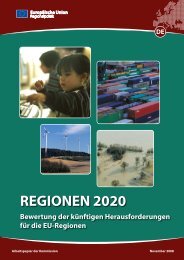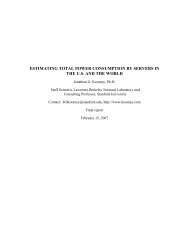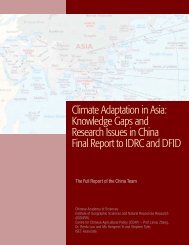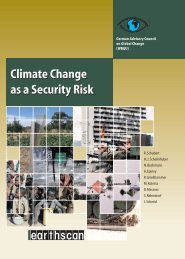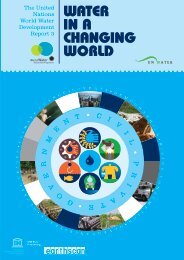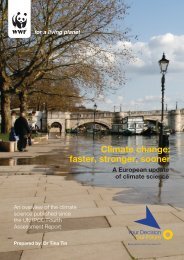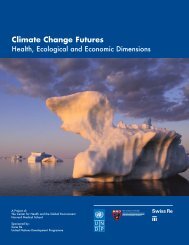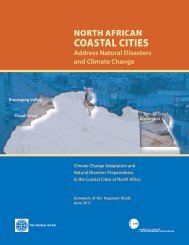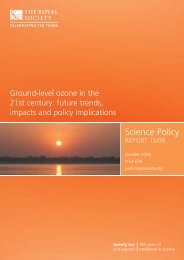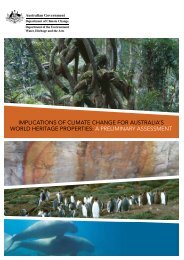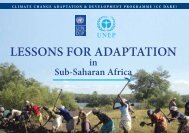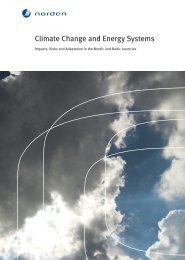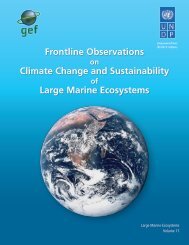Climate Change in Latin America - European Commission
Climate Change in Latin America - European Commission
Climate Change in Latin America - European Commission
You also want an ePaper? Increase the reach of your titles
YUMPU automatically turns print PDFs into web optimized ePapers that Google loves.
Table 2<br />
Country<br />
Argent<strong>in</strong>a<br />
Bolivia<br />
Brazil<br />
Chile<br />
Colombia<br />
Costa Rica<br />
Cuba<br />
Ecuador<br />
El Salvador<br />
Guatemala<br />
Honduras<br />
Mexico<br />
Nicaragua<br />
Panama<br />
Paraguay<br />
Peru<br />
Uruguay<br />
Venezuela<br />
Table summaris<strong>in</strong>g the causes of environmental pollution and the production of GHGs<br />
<strong>in</strong> the 18 Lat<strong>in</strong> <strong>America</strong>n countries, or physical factors that <strong>in</strong>crease vulnerability to climate impacts<br />
(Source: questionnaires).<br />
Environmental Problem<br />
Deforestation / transformation of natural environments, m<strong>in</strong><strong>in</strong>g operations,<br />
overexploitation of fauna and natural sites, iInterruption / modification of watercourses.<br />
Deforestation, m<strong>in</strong><strong>in</strong>g, change <strong>in</strong> soil use and degradation of soil.<br />
Deforestation / transformation of natural environments, energy.<br />
Deforestation, geographical concentration, uncontrolled <strong>in</strong>dustrial processes.<br />
No data.<br />
<strong>Change</strong> <strong>in</strong> soil use, <strong>in</strong>crease <strong>in</strong> number of obsolete vehicles, demographic pressure <strong>in</strong><br />
metropolitan area.<br />
Soil degradation, reduced forestry coverage, pollution, loss of biodiversity,<br />
lack of water.<br />
Deforestation and soil use change, forestry, enteric fermentation, waterlogg<strong>in</strong>g of rice<br />
and transport.<br />
Deforestation, transport and solid waste.<br />
Electricity generation, transport, deforestation.<br />
Energy, transport, land use change and forestry, <strong>in</strong>dustry, waste.<br />
Deforestation, energy, transport, land use change and forestry, <strong>in</strong>dustry, waste.<br />
Land-use change, agriculture and energy.<br />
Deforestation, production of greenhouse gases.<br />
Deforestation and soil use change, demographic pressure, extensive farm<strong>in</strong>g activity.<br />
Deforestation, energy, agriculture.<br />
Transport, agriculture.<br />
Progress on the agricultural front, deforestation, oil pollution, m<strong>in</strong><strong>in</strong>g.<br />
Figure 2 shows how GHG emissions are distributed <strong>in</strong><br />
percentage between the energy, <strong>in</strong>dustrial processes,<br />
agriculture, waste and land use change and forestry<br />
sectors. The data from Central <strong>America</strong>n countries<br />
lacks <strong>in</strong>formation about emissions from the farm<strong>in</strong>g<br />
sector. As regards the Mercosur countries, data for<br />
emissions from each sector <strong>in</strong> Paraguay lack details<br />
about CO 2<br />
emissions from the energy, agriculture and<br />
waste sectors.<br />
There are no great differences <strong>in</strong> the three subregions<br />
(Central <strong>America</strong>n Integration System (SICA),<br />
Andean Community and the Southern Common<br />
Market) between the distribution of GHG emissions<br />
per sector <strong>in</strong> percentage terms, although the average<br />
deforestation rates <strong>in</strong> the Central <strong>America</strong>n countries<br />
are almost double that of the South <strong>America</strong>n<br />
countries.<br />
The l<strong>in</strong>k that exists between demographical <strong>in</strong>crease<br />
and energy use, with a tripl<strong>in</strong>g of CO 2<br />
production,<br />
suggests that <strong>in</strong>vestment <strong>in</strong> energy systems has been<br />
directed towards production systems that use large<br />
amounts of fossil fuel.<br />
The greatest differences can be seen with<strong>in</strong> the<br />
sub-regions, where Cuba and Uruguay stand out as<br />
countries that have achieved a positive and effective<br />
reforestation policy (their reforestation rates are 32%<br />
and 66% respectively, over 15 years).<br />
Argent<strong>in</strong>a, Chile and Mexico are the other countries<br />
whose LUCLUF CO 2<br />
emissions stand at less than<br />
30%.<br />
The data on emissions from the agricultural sector<br />
is <strong>in</strong>complete. However, the countries that generally<br />
produce a greater proportion of emissions <strong>in</strong><br />
this sector are the Mercosur countries: Uruguay,<br />
Paraguay, Argent<strong>in</strong>a and the CAN countries Bolivia<br />
and Ecuador.<br />
Cuba is the country <strong>in</strong> the region that depends most<br />
on fossil fuels for energy production, followed by<br />
Mexico, Venezuela and Chile. The countries with the<br />
greatest emissions from the transport sector are:<br />
El Salvador, Chile, Mexico and Costa Rica. Colombia,<br />
Mexico, Argent<strong>in</strong>a and Chile are the countries that<br />
emit the greatest amount of gas from waste.<br />
Other analyses show a parallel between emissions<br />
produced by the 18 Lat<strong>in</strong> <strong>America</strong>n countries and the<br />
27 EU Member States. The numerous po<strong>in</strong>ts where<br />
the two groups of countries co<strong>in</strong>cide confirms that<br />
there could be <strong>in</strong>terchange of experiences <strong>in</strong> deal<strong>in</strong>g<br />
with these issues.<br />
19



